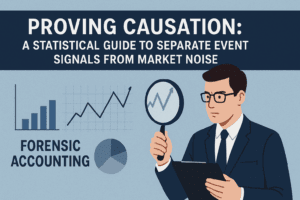US businesses lose about $50 billion to employee theft each year . Business leaders need to handle suspected employee theft properly. This isn’t just about security—it’s about financial survival for every organization.
The numbers tell a disturbing story. Three-quarters of employees admit they have stolen from their employer at least once. On top of that, 38% have done it multiple times. Organizations lose an average of $1.78 million per fraud case . All but one of these cases lead to serious financial damage, and almost one-third of US bankruptcies stem from employee theft .
A proper theft investigation process needs careful planning, legal compliance, and expert knowledge. Forensic accountants play a significant role in these situations. They use their expertise to track missing funds and document financial irregularities. This piece guides business leaders through steps to protect their organizations. They’ll learn everything about investigating workplace theft—from spotting warning signs to setting up preventive measures that protect company assets.
When and Why to Launch an Employee Theft Investigation
American businesses lose due to employee theft $10-50 billion each year[1]. Nearly one-third of business bankruptcies stem from internal theft [2]. Business owners need to know the right time and reasons to start a formal theft investigation. This requires a clear understanding of financial risks and proper procedures.
Understanding the impact of theft in the workplace
The numbers paint a shocking picture. , while 75% of employees admit they’ve stolen from their employers at least once 95% of businesses face theft[2]. What’s worse, employee theft usually goes undetected for 14 months before anyone finds out [2]. This gives thieves plenty of time to cause serious financial damage.
Employee theft comes in many forms, from basic cash register skimming to complex embezzlement schemes. Here are the most common types:
- Billing fraud and asset misappropriation (18%)
- Cash on hand theft (15%)
- General theft and larceny (11%)
- Check and payment tampering (10%)
- Payroll fraud (10%) [2]
Small businesses face bigger risks. Companies with less than 100 employees lose more money than larger ones [3]. The problem gets worse because 79% of theft cases involve multiple people—usually three per scheme [2]. This teamwork makes theft harder to spot and highlights why businesses need forensic accounting experts.
When informal action is not enough
Not every theft suspicion needs a formal investigation. Yet some warning signs call for qualified professionals to take a closer look. A formal theft investigation becomes vital when:
Financial records show unexplained gaps in cash amounts or inventory levels [4]. Staff members resist new internal controls or won’t share their duties [3]. Workers show lifestyle changes they can’t explain with their salary [4]. Several witnesses report suspicious behavior [4].
Minor misunderstandings about company policies might be resolved informally [5]. But systematic financial irregularities or complex fraud patterns need forensic accountants to uncover the truth.
Balancing urgency with legal caution
Businesses must act carefully with suspected theft to avoid potential lawsuits. Yes, it is important to know how to handle these situations while staying within legal bounds.
Start by reviewing whether you need a formal investigation—not every case needs deep analysis [6]. But forensic accounting experts suggest looking into even small thefts. This helps avoid rushed conclusions that could lead to legal trouble [7].
Keeping investigations private protects everyone involved [8]. Good documentation creates a paper trail for possible legal action [6]. Save all evidence like financial records, computer files, and emails. Make sure you can prove who handled them and when [9].
Build a strong case before confronting anyone. Video evidence works best, but witness statements can help too [9]. Forensic accountants provide detailed financial analysis that holds up in court.
Companies with theft insurance usually need to file a police report [9]. Talk to your insurance provider before starting formal investigations to meet all policy requirements [7].
Building the Right Investigation Team
Building an effective team is vital to investigate theft in the workplace. The team’s composition often determines whether the investigation succeeds or fails.
Role of forensic accountants in theft cases
Forensic accountants are the backbone of many employee theft investigations. The American Institute of CPAs defines as “the application of specialized knowledge and investigative skills possessed by CPAs to collect, analyze, and evaluate evidential matter, and to interpret and communicate findings in the courtroom, boardroom or other legal or administrative venue” forensic accounting[10]. These specialists blend accounting expertise with investigative techniques to identify financial irregularities.
Forensic accountants take a structured approach to suspected employee theft. They first determine the calculations needed to measure potential losses. They analyze details to separate legitimate business transactions from personal expenditures [10]. This work includes reviewing bank statements and financial records while conducting interviews with key personnel.
Forensic accountants handle three main types of employee loss claims:
- Asset misappropriation
- Bribery and corruption
- Financial statement fraud
Their expertise goes beyond investigations. They provide expert testimony in legal proceedings and help judges and juries understand complex financial matters [11]. Businesses lose an average of $1.13 million annually to employee theft according to . The preventative measures these accountants put in place are a great way to get returns on investment recent data[12].
When to hire external investigators
Some situations just need external investigators instead of internal resources. External investigators become essential if allegations involve high-level employees or corporate officers. This creates a buffer against potential conflicts of interest [13].
External investigators prove especially valuable in these cases:
- The complainant has hired legal counsel or filed suit
- Sensitive cases arise with serious complaints (harassment, discrimination, theft/embezzlement)
- Allegations could lead to major financial exposure or negative media coverage
- Internal teams lack expertise or resources to complete timely investigations [13]
A legal expert points out that “A misstep in any of these areas can lead to a finding of lack of good faith, which could place the company in a potentially worse position than if no investigation had been conducted at all” [13]. Professional investigators bring specialized expertise that internal teams can’t match. They stay independent from organizational politics while conducting thorough examinations [14].
Importance of legal and HR collaboration
Theft investigations need coordination between multiple departments. Most companies find their internal investigations involve legal, internal audit, and HR teams working together [15]. Information silos can develop over time and lead to inconsistent results and duplicate efforts.
Organizations should create a matrix that outlines each group’s roles and responsibilities based on the issue type [15]. This approach sets clear protocols for sharing information, following up, and communicating effectively.
The investigation team needs members with varied expertise. Team leaders direct investigations and communicate with stakeholders while assigning duties. Team members collect data, establish event sequences, analyze information, and prepare final reports [2]. This cross-functional collaboration with technical experts ensures technical, legal, and ethical standards remain high throughout the process [16].
Make sure your investigation team has solid evidence before confronting suspects. Forensic accountants provide financial analysis that holds up to legal scrutiny—a vital element in handling suspected employee theft properly.
Planning and Executing the Investigation

Image Source: AIHR
Employee theft investigations need careful execution after putting together the right team. The investigation must follow specific steps to protect evidence and stay within legal bounds.
Gathering documents and digital evidence
Evidence collection sets the foundation for any theft investigation. A forensic accountant usually secures:
- Financial records (journal tapes, receipts, expense reports)
- Employee records (timecards, sign-off sheets)
- Digital evidence (emails, computer files)
- Video surveillance footage when available
Evidence handling needs proper documentation about who collected it and how they got it. This creates what investigators call a “chain of custody.” The evidence stays credible and usable in court this way. Photos of items in their original spots, along with time stamps and location notes, will boost evidence reliability.
Creating a timeline of events
Complex theft cases become clearer with chronological organization. Forensic accountants often use a three-column format that shows the date, time, and description of each important event. This helps a lot when investigations grow and events start connecting.
Timelines work great during witness interviews to piece together what happened. Investigators can spot when people tell partial truths while hiding information. The timeline also helps ask better questions since all events are right there for reference.
Interviewing witnesses and suspects
Structured interviews are the foundations of theft investigation. Investigators should review all evidence that proves the suspected employee’s involvement before any interviews. They need to outline how they’ll present facts and bring in a neutral witness—usually a manager or HR person—to document everything.
The interview starts with background questions to build trust before moving to policies and procedures. This removes the “I didn’t know it was wrong” excuse later. Everything gets documented, including when interviews start and stop, and written proof that employees can end the interview anytime they want.
Maintaining confidentiality throughout
Confidentiality plays several vital roles: it protects the investigation, keeps evidence fresh, and guards employee’s personal information. Instead of strict confidentiality rules, investigators should explain why each case needs privacy.
Rather than demanding secrecy, investigators can explain how privacy protects everyone and keeps investigations on track. This balances the need for discretion while respecting employee’s legal rights to talk about workplace conditions.
Evaluating Evidence and Making Decisions
The evaluation phase starts after gathering evidence in any employee theft investigation. A proper assessment of evidence helps confirm theft and determine the right consequences.
How to assess financial and behavioral red flags
Understanding common fraud indicators kicks off the evidence evaluation process. Research shows that show at least one behavioral red flag while committing crimes 85% of fraudsters[17]. These warning signs follow clear patterns:
- Living beyond means (42% of cases) – the most common indicator since 2008 [17]
- Money problems (26% of cases) – including unexplained personal debts [17]
- Control issues and refusal to share duties (15% of cases) [17]
- Too-close relationships with vendors or customers (19% of cases) [17]
Unexplained differences between bank statements and internal ledgers often point to fraud [9]. Regular payments to unknown vendors with missing contact details might suggest fake invoicing schemes [18].
Using forensic accounting to trace fraud
Forensic accountants are vital in evaluating theft evidence through specialized techniques. They track money flows, examine complex financial data, and spot irregularities others might miss [7]. Their step-by-step approach works like this:
They start by figuring out the calculations needed to measure possible losses. Then they do detailed analysis to separate business transactions from personal spending [7].
These experts excel at finding suspicious patterns in financial statements and bank reconciliations [19]. They use methods like the Lowest Intermediate Balance Rule to calculate exact amounts stolen when funds get mixed together [20].
Deciding on disciplinary or legal action
Companies need to choose appropriate action once evidence confirms theft. Best practices suggest thinking over:
The theft’s size and severity, the employee’s work history, and how well they cooperate during the investigation [21]. Options range from suspension to firing for serious misconduct in validated cases [21].
Legal counsel’s input is needed before taking any disciplinary steps [22]. This protects the organization and gives the accused employee fair treatment [21].
Companies need to balance recovery efforts with legal requirements and decide whether to press charges, ask for repayment, or handle things internally [23].
Post-Investigation Actions and Prevention
Employee theft investigations don’t end with conclusions. They mark the start of crucial changes to make organizations better. Smart follow-up actions protect companies and make their controls stronger.
Documenting the investigation process
Legal proceedings need solid records. A complete investigative report should include:
- Summary of allegations
- Description of evidence collected
- Interview summaries
- Chronology of events
- Statement of findings
- Recommended actions
Forensic accountants create detailed financial analyzes that stand up in court. The team must keep a proper chain of custody for all documents, computer files, and emails to preserve evidence.
Communicating outcomes to stakeholders
Companies need smart ways to balance openness with privacy. The accuser deserves acknowledgment and closure: “After a full review, we’ve determined that action has been taken. To maintain employee privacy, specific details cannot be shared.” Witnesses and managers should only know what helps them do their jobs.
Updating internal policies and controls
Investigations often show weak spots that need quick fixes. Forensic accountants spot these issues and suggest better financial controls. The solutions might include splitting up duties, better inventory tracking, or new rules for approving financial transactions.
Training staff to prevent future incidents
Good training programs help people spot and stop theft. Clear rules should spell out what counts as theft—including tricky areas like lost-and-found items, unauthorized discounts, and time theft. The team needs regular reminders that theft hurts everyone through lower profits, damaged relationships, and broken trust.
Conclusion
Employee theft poses a substantial threat to businesses of all sizes. The staggering losses——show why organizations need to take this issue seriously. This piece outlines a detailed approach to tackle workplace theft while staying legally compliant.$50 billion annually
Forensic accountants are the life-blood of successful theft investigations. Their expertise helps trace financial irregularities, document evidence properly, and deliver expert analysis that holds up in court. Companies with unexplained losses or suspicious money patterns get great value from these professionals who can spot the difference between honest mistakes and planned fraud.
The investigation needs careful attention to detail. Evidence collection and suspect interviews need both technical know-how and legal awareness. Companies that skip these steps risk ruining their cases or facing lawsuits from employees who believe they were wrongly accused.
Companies must look beyond the whole ordeal after a theft. Strong internal controls, regular financial audits, and detailed staff training create an environment where theft becomes tough and risky. In spite of that, even the best prevention systems can fail, which makes forensic accounting expertise crucial for both investigation and recovery.
Internal teams don’t deal very well with employee theft investigations because they lack specialized knowledge. Professional forensic accountants bring objectivity, unique techniques, and courtroom experience that can turn the tide between success and ongoing financial bleeding. Their expert testimony becomes especially valuable when cases go to court.
Employee theft’s financial and reputation costs go way beyond the reach and influence of the stolen assets. Organizations must balance thoroughness with speed when they handle suspected theft. Good documentation, confidentiality, and following legal requirements protect the business and its employees throughout the process.
Stopping employee theft completely might seem impossible. However, businesses with forensic accounting expertise and proper investigation methods can substantially cut their risk while ensuring quick, effective responses to theft. This mix of prevention and preparation offers the best shield against workplace theft’s ongoing threat.
Key Takeaways
Employee theft costs US businesses $50 billion annually, making proper investigation protocols essential for organizational survival and financial protection.
• Act quickly but legally: Launch formal investigations when financial discrepancies appear, but balance urgency with legal compliance to avoid litigation risks.
• Hire forensic accountants: These specialists trace financial irregularities, document evidence properly, and provide expert testimony that withstands legal scrutiny.
• Follow structured investigation steps: Gather documents systematically, create chronological timelines, conduct structured interviews, and maintain strict confidentiality throughout.
• Document everything thoroughly: Maintain proper chain of custody for evidence and create comprehensive reports that include findings, chronology, and recommended actions.
• Strengthen prevention systems: Update internal controls, implement staff training programs, and establish clear policies to prevent future theft incidents.
The investigation process requires specialized expertise that internal teams often lack. Professional forensic accountants bring objectivity, advanced analytical techniques, and courtroom experience that can determine the difference between successful resolution and continued financial losses. Their ability to distinguish legitimate transactions from fraudulent activity proves invaluable in complex theft cases.
FAQs
Q1. What is the 10-80-10 rule in employee theft? The 10-80-10 rule suggests that in any organization, 10% of employees will never steal, 10% will always look for opportunities to steal, and 80% may steal depending on circumstances. This rule emphasizes the importance of creating a work environment that discourages theft among the majority.
Q2. How can businesses protect themselves from employee theft? Businesses can protect themselves by implementing strong internal controls, conducting regular financial audits, using surveillance systems, and fostering a culture of integrity. Additionally, thorough background checks during hiring and ongoing employee training on ethics can significantly reduce theft risks.
Q3. What should a manager do if they suspect an employee of stealing? If a manager suspects employee theft, they should first document their observations and gather evidence discreetly. It’s crucial to avoid making accusations without proof. The manager should then report their suspicions to HR or the appropriate authority within the company to initiate a formal investigation process.
Q4. What role do forensic accountants play in employee theft investigations? Forensic accountants are crucial in employee theft investigations. They use specialized skills to analyze financial records, trace fraudulent transactions, and provide expert testimony if needed. Their work helps uncover complex theft schemes and produces evidence that can withstand legal scrutiny.
Q5. How can companies effectively communicate about theft incidents to their staff? When communicating about theft incidents, companies should balance transparency with privacy concerns. They should acknowledge that action has been taken without sharing specific details about individuals involved. It’s important to use these incidents as opportunities to reinforce company policies, emphasize the impact of theft on the entire team, and reaffirm the organization’s commitment to preventing future occurrences.




